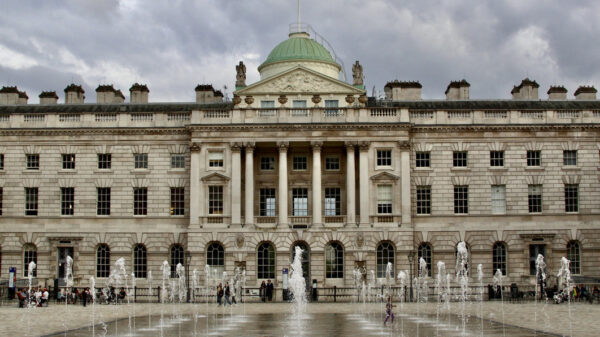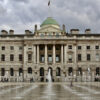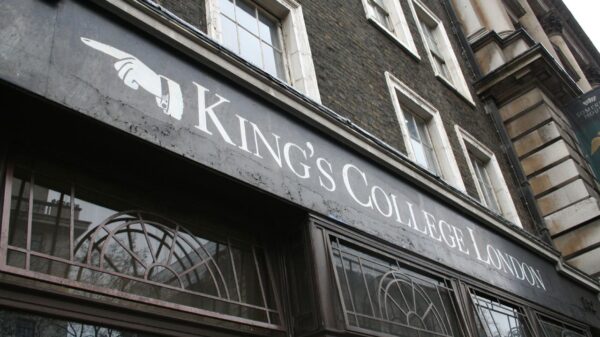Roar writer Scarlett Yu on stage designer Es Devlin and her upcoming project in Somerset House taking place this summer.
It isn’t a common landscape to see nature being incorporated into a setting of medieval grandness in present society, especially in the conspicuous hub of one of the world’s most bustling, exhilarating cities. Excitingly, in 2021, the global community is able to witness a striking, visual transformation, enacted through the creative power of design as one of the most lavish sites of London is infused with a refreshing stream of natural wonder and greenish vigour.
This summer, renowned stage designer Es Devlin will be showcasing her artistic talent with an anticipated vision, bringing potent social impact in times of crisis at a global scale. A 400-tree forest will be moved into Somerset House’s central courtyard, reconstructing a historical background with the liveliness of an “enchanted woodland“. It is highlighted that the trees would be picked from 23 types of timber from across the UK and northern Europe, gearing towards the authentic depiction of a national imagination which feeds on rich inspirations generated from artistic innovation and creative strength. Devlin sees the spatial potential of Somerset House to be visually transformative in order to break through historical boundaries of tradition and conservative thought.
Many years ago, upon visiting Somerset House, Devlin noticed how the building, which was built on Enlightenment principles, ironically prohibited the inclusion of trees into the spacious setting of the house. She felt the spiritual need to overturn the stagnant situation surrounding Somerset House, which is constrained and transfixed by a conventional rule appointed by the standard systems of society. Long standing as a representative site of Europe’s historic richness and sublime beauty, something needed to change in order to correspond closely with the erratic changes and fluctuations of globalisation in the modern era. Thus, a bold, unprecedented thought pierced through Devlin’s mind where she seeks to utilise nature as a creative sign of change in tackling main global issues and challenges people are currently facing. She explains her ideas:
“The first thing we wanted to do when considering this year’s Biennale was to counter this attitude of human dominance over nature by allowing a forest to overtake the entire courtyard.”
In an unsettling age of crisis, society desperately needs a novel force of motivation and inspiration in order to move forward. This is where the effective role of design comes in, providing people with numerous ideas and perspectives that could potently drive them to think and act in unprecedented ways; potentially offering a different outlook on their relationships with the surrounding world, and the contemporary issues that inhabit it. Responding to this global design call to address revolving social issues, Devlin uses the theme of Resonance as the central ideology of her design project. She explained the significance of identifying how works of design could profoundly affect and transform ways of thinking as well as the societies that thrived upon these shifting thoughts:
“We live in an age of hyper resonance, the consequences of which are both exhilarating and devastating. Everything we design and everything we produce resonates.” She continues, “attitudes can evolve and lives can be improved when new ideas resonate and are adopted by extended communities”.
Aware of the amount of potential art has in generating a tremendous impact on people’s lives and their worldview, Devlin integrates the idea of resonance into the Somerset House design project, anticipating that the art she presents to the world could reach into people’s hearts with sensational moments of impact. Her plan to place an opulent forest in the middle of the courtyard is tied to a movement called “Forest for Change“, where, in partnership with Project Everyone, she aims to invite the perceptions of the UN’s Sustainability Development Goals into spotlight; this includes eradicating worldwide poverty, raising awareness of inequality, and sustaining plans for climate change. Devlin believes that “forests are a place for transformation” in literature, and by placing the presence of trees in the midst of historic significance, it serves as a bold yet transformational move to interact with the goals of UN.
Conclusively, Devlin hopes that this green, conspicuous landscape will help people think about how they could demonstrate roles of support and strength in tackling global challenges and concerns. Her efforts to call upon global issues worldwide through the stimulative effects of radical design serve as an innovative force in eliciting global societies about how many of the social problems we are facing could be approached in a different angle — sparking the theme of Resonance within the wider design community.
In a determined note of belief, Richard Curtis, co-founder of Project Everyone, asserted the creative landscape as a means to converse with communities of possible future visions about opportunity and hope. The combined visual experience of historic architecture and nature prompted a bold and thorough attitude in facing these goals; crucially, “the goals are the answer to the challenges we are facing, and a pathway towards building a better and brighter future for everyone, everywhere”.

















